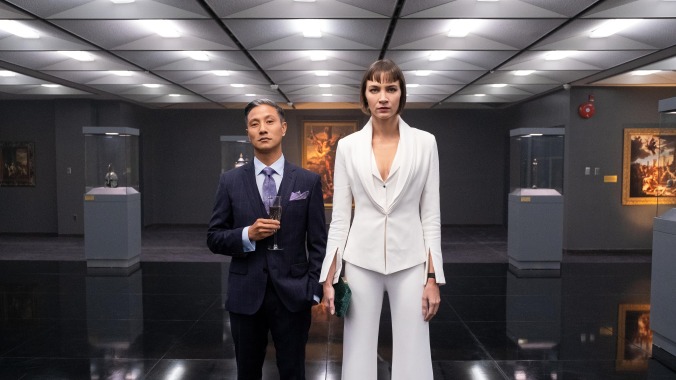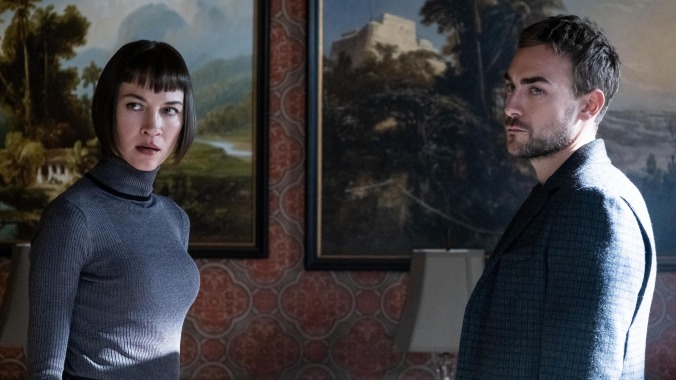Hulu’s Helstrom struggles without MCU hooks to fall back on


Helstrom, Hulu’s second Marvel adaptation after Runaways, started life as an attempt to build a horror-themed branch of the Marvel Cinematic Universe called “Adventures Into Fear” that—unlike Daredevil and the other Marvel shows on Netflix—would actually establish tangible connections to the movies. Those plans fell apart when Marvel Television was absorbed into Marvel Studios, leading to the planned Ghost Rider series being canceled and all of Marvel’s TV plans shifting over to the “real” MCU tie-ins on Disney+.
That left Helstrom in an odd place: Its reason for being made was evidently gone, thereby giving it a chance to exist on its own terms outside of the shadow of the MCU, and losing that leash seems to have been a boon for the final product. With no direct ties to anything other than the comic book characters it’s based on, Helstrom doesn’t need to waste time addressing why Doctor Strange doesn’t show up to solve demonic problems or why Stark Tower isn’t in the New York skyline (Helstrom takes place primarily in Oregon, so there’s no need to show Stark Tower ever, but its absence was one of the more frustrating things about the supposedly MCU-connected Netflix shows.)
Helstrom, to its credit, is better off without the MCU weighing it down, but that still doesn’t mean it’s entirely successful. In fact, more than anything Marvel-related, the show is very reminiscent of something from the DC universe: NBC’s short-lived Constantine. They’re both about flawed people hunting demons, they’re both based on characters from comic books, and they both take place in a world of perpetual gloomy weather. Unlike that series, though, which was able to lean on the strength of John Constantine as a character (and star Matt Ryan’s performance, which was solid enough to convince Warner Bros. to bring him and his Constantine to the Arrowverse on The CW), Helstrom doesn’t have nearly as dynamic of a protagonist.
Instead, it has Daimon and Ana Helstrom, two siblings who were confronted with a demonic entity as children and, naturally, grew up kind of damaged. Daimon (played by Tom Austen) was raised by their mother (Elizabeth Marvel, who does a fine job juggling what is essentially two characters), while Ana (Sydney Lemmon) spent significantly more time with their father, a man who later turned out to be a prolific serial killer. Ana hates their mother for not trying harder to stop their father, while Daimon feels sympathy toward his mother because she’s been locked up in a mental institution since he and Ana were kids. Oh, also, the mother is possessed by a demon, and the show doesn’t waste any time whatsoever before confirming that, yes, she is definitely possessed, demons are real, and there’s no chance that any of this is all some misunderstanding by a couple of siblings who are desperate to blame their rotten childhoods on something other than a mentally ill mother and dangerously violent father.
On the one hand, hey, good for Helstrom for resisting a rather clichéd impulse. On the other, it does feel a bit too easy for the show to immediately insist that Evil is real, the Helstroms can do magic, and that you should just go with it. It would be one thing if Helstrom used that to go to interesting places, either visually or narratively, but the magical aspect of its world never really goes beyond the fact that demons exist and some people can do magic. Plus, the demons themselves almost always just look like people, even when they’re not out walking around in the real world, despite an ever-present MacGuffin (a demon skull) that hints at monsters who look a little more interesting than just regular people who scowl a lot.
If Helstrom is intent on being a show about people, rather than flashy demonic prosthetics or digital effects, then it’s a shame that the people it centers on aren’t always very engaging. Daimon in particular is a bit dull for a demon-hunter, even if Austen does his best to insert some of that Tony Stark-style MCU snotty charm, but Helstrom wisely doesn’t try to push him as some kind of annoyingly likable jackass like a John Constantine or a pre-magic Doctor Strange. Nobody in the show really likes Daimon Helstrom, and it’s easy to see why, which at least feels like a more honest choice than positioning him as a sexy antihero (comic book Daimon is always shirtless and has an inverted pentagram etched onto his chest, but this incarnation thankfully isn’t that in-your-face).
Ana, meanwhile, is slightly better served. For starters, Lemmon’s sharp hairstyle in the show looks like something a cool comic book character would have, even if it’s not strictly the same look she has in the comics (Ana’s comic book counterpart has big horns usually), and that alone makes her come across as a bit more special than the normal people she crosses paths with. Lemmon’s performance is also fun, drifting between being too cool for school, giving in to an endless supply of bitter rage, and then setting all of that aside so she can open up to the few people who actually “get” her.
Helstrom doesn’t have the panache of the Marvel Cinematic Universe, but it is a serviceably spooky TV series with some interesting hooks about how demonic parentage influences nature versus nurture, and there are also some reasonably clever ideas about how demon-busting would work in something resembling the “real world.” That being said, the central duo could stand to gain a little bit of comic book flair, especially if we’re supposed to accept that the various nightmares they deal with on a daily basis are as scary as Daimon and Ana insist they are. The show really is better off having exorcised any obvious comic book connections, but it struggles to find anything especially unique to fill that void.